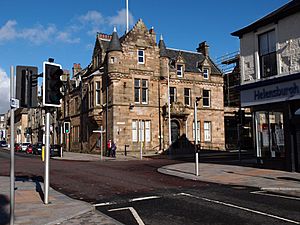Municipal Buildings, Helensburgh facts for kids
Quick facts for kids Municipal Buildings, Helensburgh |
|
|---|---|

Municipal Buildings, Helensburgh
|
|
| Location | Princes Street East, Helensburgh |
| Built | 1879 |
| Architect | John Honeyman |
| Architectural style(s) | Scottish baronial style |
|
Listed Building – Category B
|
|
| Official name: 1 Princes Street East And 48, 50, 52, 52A Sinclair Street, Municipal Buildings | |
| Designated | 30 June 1993 |
| Reference no. | LB34825 |
| Lua error in Module:Location_map at line 420: attempt to index field 'wikibase' (a nil value). | |
The Municipal Buildings in Helensburgh, Scotland, are special old buildings. They are found on the north side of Princes Street East. These buildings used to be the main office for the local council, which is like the town's government. Today, they are a Category B listed building, meaning they are important and protected because of their history and design.
Contents
A Look Back: The Story of the Buildings
Why Helensburgh Needed New Buildings
Helensburgh grew a lot in the 1800s. This was partly thanks to Henry Bell. He helped bring more tourists and shipbuilding jobs to the area. Because the town was growing, it became a "police burgh" in 1846. This meant it could have its own local government.
The new town leaders first bought an old theatre in 1850. They used it as their office. But Helensburgh kept growing, especially after the Glasgow, Dumbarton and Helensburgh Railway arrived in 1858. So, the town leaders decided they needed a bigger, better building. They chose to knock down the old theatre and build something new.
Building the New Town Hall
The first stone for the new building was placed on 15 August 1878. A former Member of Parliament, Alexander Smollett, did the honors. The famous architect John Honeyman designed the building. He used the Scottish baronial style, which looks a bit like a Scottish castle.
The building was made from smooth, cut stone called ashlar. It cost £4,454 to build, which was a lot of money back then! The Municipal Buildings officially opened on 13 July 1879.
Special Features of the Design
The building's front facing Princes Street East is quite unique. It has an uneven look with four main sections. One section sticks out a little and has a pointed roof. It features different types of windows, including a three-part window and a cross-shaped window. It also has small, round towers called bartizans on its corners, just like a castle.
Another section has a main doorway. Above the door, there's a round arch with a special stone. This stone has a carving of Henry Bell, the man who helped Helensburgh grow. The doorway is also decorated with columns and brackets that hold up a stone beam with a coat of arms (a special symbol for the town). Inside, the most important room was the council chamber, where meetings were held.
Expanding the Buildings
In 1906, the buildings got bigger. Twelve more sections were added to the north side. This new part was designed by Alexander Nisbet Paterson. It made space for a fire station, a courthouse, and a police station.
The architect added some fun details. Above the police station entrance, you can see carvings of handcuffs. And high up on the roof, above the courthouse entrance, there's a carving of a cat! This was because the architect really liked cats.
In May 1952, a special plaque was put on the front wall. It honors John Logie Baird, a famous inventor born in Helensburgh. The town's leader, William Lever, unveiled it.
Royal Visit and Changes
The buildings went through a big restoration project that cost £1 million. After the work was done, Queen Elizabeth II and the Duke of Edinburgh came to reopen the building in June 1965. They also met with the town officials.
Later, the police and fire services moved to new stations. The police left in the late 1960s, and the fire service moved in the mid-1970s.
What Happened Next
The Municipal Buildings were the main office for the town council for most of the 20th century. But in 1975, a larger council, the Dumbarton District Council, took over. The buildings were then used for other local services.
However, after Argyll and Bute Council became the main local government in 1996, they found problems with the building. It was left empty and started to fall apart. The council didn't need the building anymore because they moved their services to a new center in Clyde Street in June 2015.
In 2019, the building was sold to a company that planned to turn it into a restaurant. In 2023, a bar and restaurant called Peckham's opened there.
See also

